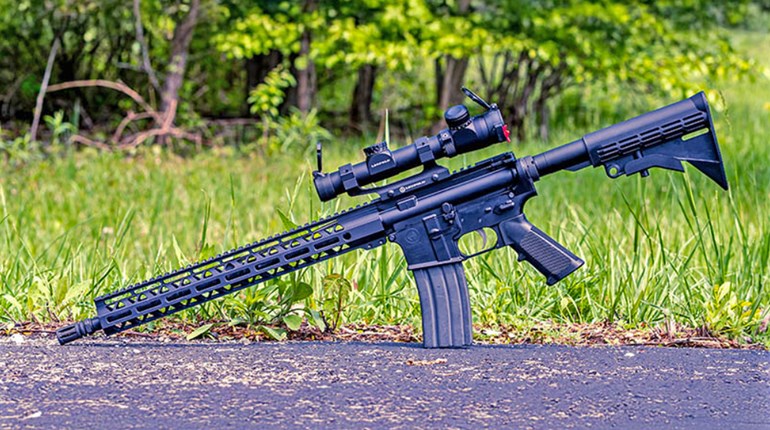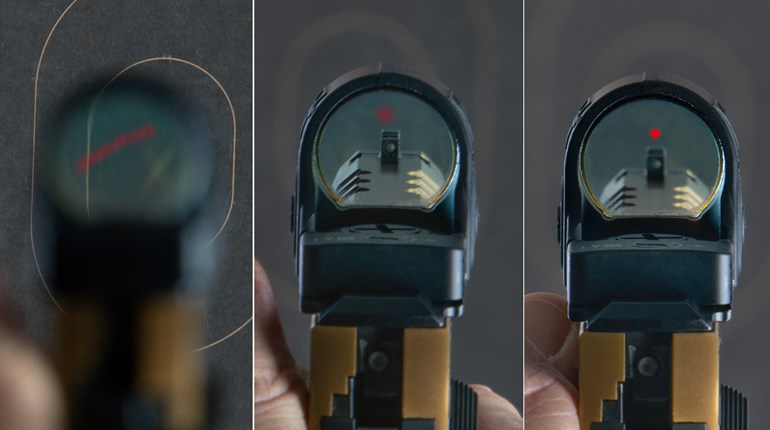
This article, "Using Carbine Modularity Wisely," appeared originally as a Handbook in the November 2017 issue of Shooting Illustrated. To subscribe to the magazine, visit the NRA membership page here and select Shooting Illustrated as your member magazine.
Modularity is both a blessing and a curse, and the Modern Sporting Rifle (MSR), also known as the AR-15, has it in spades. The plethora of rails, flashlights, lasers, optics, grips, pressure switches, flare launchers, vertical grips, muzzle brakes, flash hiders, hand stops and accessory mounts designed and produced for the AR-15 is simply mind-boggling—and has turned the MSR into a Lite Bright for bad ideas. The good news is the millions of dollars and man-hours spent in the pursuit of the MSR accessory market have produced some truly inspired designs, which have increased the platform’s effectiveness as a military, law enforcement, defensive and recreational tool.
The challenge for the AR-15 owner isn’t whether something exists to enhance your system’s performance, it’s a question of which combination of products best meets your needs. While the boom in sales of MSRs in recent years has introduced an entirely new segment of the shooting community to the joys of the AR-15, it has also created confusion in the user’s mind about which set of accessories is best for them. There are as many answers to this question as there are MSR owners. However, having a starting point from which to work can save you time, money and frustration.
I dislike the label of “general-purpose carbine.” Each of our missions, environments, state laws, resources, shooting styles and tastes are different, and what would serve me well may not be suited to your uses of the carbine at all. This is the heart of what makes the MSR so popular: everyone can make his or her own individual “general-purpose carbine,” tailoring it perfectly to your particular circumstances.
In my more than 20 years of teaching MSR users and consulting with police departments and SWAT teams on the selection of their equipment, I have developed a set of recommendations for basic configurations. These serve as a good starting point for defensive MSRs, while allowing for adding capabilities to the carbine as your resources or needs expand. I have labeled these four basic configurations by “type” simply to keep them straight in my head. Please keep in mind I come at this from a “working gun” perspective, and all of these types are built around that view.
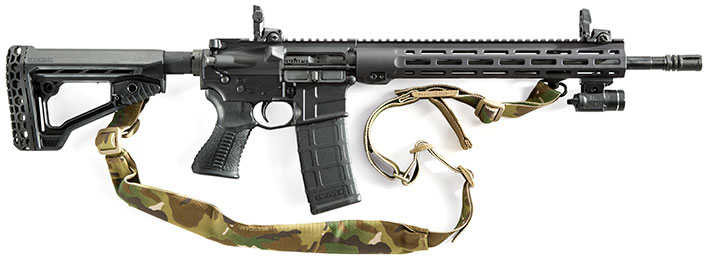
Type 1 AR-15
A Type 1 AR-15 is a basic and inexpensive, yet functional, carbine. First, if you haven’t already bought your MSR, chose a quality brand and model with a proven track record. I prefer mid-length, direct-gas-impingement operating systems because of the added reliability the longer gas system provides. If you are working with a carbine you already own, you have to “dance with the one that brung ya.” Take it to the range and make it prove its reliability before you invest any money in turning it into a defensive arm. If it cannot cut the mustard, sell it and buy yourself a quality mid-length-gas-system AR-15.
The Type 1 carbine, in my mind, is equipped with iron sights as the primary sighting system. While I prefer and use an optical sighting system for my defensive and work carbines, good old-fashioned iron sights have served the armed citizen well for centuries. There is no doubt a quality red-dot or other optical sight will enhance the system’s effectiveness, but it is not an absolute necessity in my opinion. With training and dedicated practice, modern AR-15 iron sights are not a handicap. For some folks, the expense of a quality optical sight makes it a luxury that may have to be deferred.
A carbine-mounted flashlight and sling, however, are absolute must-haves on any defensive MSR. The ability to positively identify targets at night and to have your hands free without setting the carbine down is absolutely essential in defensive applications of any kind.
If you cannot get both the flashlight and sling at the same time, get the flashlight first. For those who pay attention to the cacophony of noise on the internet, there may be some confusion as to the advisable power and quality of a carbine-mounted flashlight. My opinion, based on years spent searching buildings, yards, fields, sheds, cars, henhouses, trailer homes and department stores looking for people who wouldn’t mind killing me, is that you can never have too much light. The minimum power of light I allow on my carbines is 500 lumens. Period. I have never “blinded” a teammate or myself by shining my light on a white wall or any other such nonsense. Place the light on the rail or front sight post where it does not obstruct your vision through the sights, and where you can activate it from your normal shooting style.
Slings are holsters for your carbine, and like a holster, quality and type matter. There are three basic types of slings on the market: single-point, two-point and three-point. The single- and two-point slings have their places and advocates, while the three-point sling is a carry-over from the old days when we used them on Heckler & Koch MP5s—you should not consider it a viable option for a modern carbine or rifle. Single-point slings are designed for work in close quarters and in situations where firearm retention and vigorous movement are unlikely. The downside of the single-point sling is when you let go of the carbine, it flops around like an 8-pound pendulum if you move in any direction. Also, it is difficult to trap the carbine close to your body if you need to put your hands on someone.
I prefer two-point slings because they can be easily tightened or loosened, can be transitioned to your back quickly (helpful when climbing, crawling or otherwise not standing still) and can be trapped against the body when transitioning to the handgun or otherwise using your hand. The downside of the two-point sling is…well, nothing I’ve found yet. I’ll let you know when I do.
Starting with a Type 1 MSR allows you to field a capable system immediately at the lowest cost possible, while leaving you room to expand into optics and lasers as the resources become available. The other types of carbines we’ll cover are built upon the Type 1. If your finances allow, skip the Type 1 and go straight to the type that best meets your mission needs.
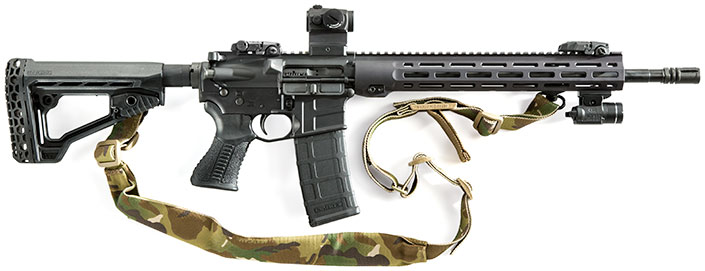
Type 2 AR-15
Building upon the Type 1 MSR, the Type 2 is the same system with the addition of a red-dot or holographic sight and (optionally) a laser-sighting system. While iron sights are serviceable, a red-dot sight enhances your carbine’s capabilities significantly in several ways. First, a red-dot sight eliminates the need to line up three objects in space (the rear sight, front sight and target) while focusing on the one in the middle. While this focus becomes second nature with training, it still takes time to do in real life. If your carbine is intended for defensive use, every millisecond is life or death in a gunfight, and the milliseconds gained by being able to just focus on the target (which your brain wants to do anyway) and put the dot where you want the bullets to go (compensating for offset at close range), could be the margin you need. A red-dot sight also allows for more-precise shots in low-light conditions, reduces the imperative of a perfect cheek weld and makes shooting from unusual positions a more-realistic affair.
When shopping for red-dot sights, keep in mind there are two types in common circulation: the red-dot sight (popularized by Aimpoint) and the holographic sight (popularized by EoTech). Without getting too far in the weeds, suffice to say I strongly prefer the red-dot sight, specifically the Aimpoint Micro T1. Whichever you choose, I cannot urge you strongly enough to save your money and buy it right the first time. Knockoffs are just that: knockoffs. Also keep in mind the mount you use to attach the optic to the carbine is as important as the optic itself. Do your research and buy it once.
Lasers are a sometimes misunderstood and often misused AR-15 accessory. I use lasers for specific applications, but those uses are fairly specialized. If you have a realistic expectation you will need to use your carbine while wearing a gas mask or night vision, you need a multi-function aiming laser. If, however, you are using the laser as a substitute for a sighting system or so you can shoot “from the hip,” I would strongly counsel you to just skip it and spend that money on ammunition and quality training.
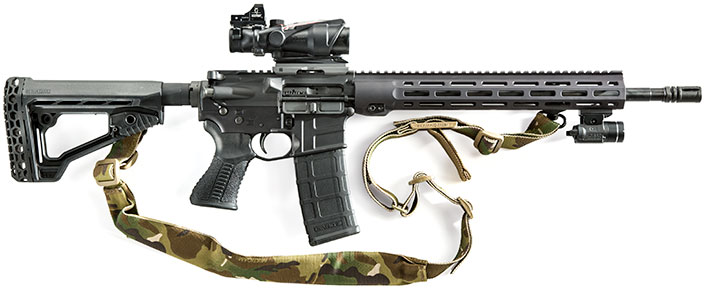
Type 3 and Type 4 AR-15s
Type 3 and 4 MSRs are Type 2 MSRs with more specialized optics. The Type 3 MSR incorporates a fixed-power magnified optic, usually in a 4X or 6X configuration. If you intend to use the carbine in an environment overwhelmingly involving long distances (the high desert for example) with very little chance of having to work with it inside of structures, a fixed-power magnified optic makes a lot of sense. While the fixed-power optic can be used at close range, it is less than optimal and requires a large amount of training to do so effectively and reliably. For this type of carbine, I prefer the Trijicon 4x32 mm TA31 because of its forgiving eye box, proven ruggedness and the large selection of mounts available on the market. Whatever optic you choose, please consider saving up and buying it right the first time.
The Type 4 MSR is a Type 2 equipped with a variable-power optic. For a Type 4 MSR I suggest a high-quality, variable-power scope with a 1X or 1.1X low power, up to 4X, 5X or 6X range. This is the most versatile of all the AR-15 types, giving you the ability to work very close to all the way to the outward edge of the .223 Rem./5.56 NATO ballistic envelope. This versatility, however, comes at a price. Variable-power optics require a significant amount of training effort in order for you to become accustomed to the specific eye-relief, reticle use, power adjustment and range-estimation skills required to get the full use of your particular optic. Having said that, if by some freak accident of law or circumstance I could only have one AR-15, it would be a Type 4 MSR or a Type 2 MSR with a 3X magnifier behind the unmagnified red-dot sight (making a kind of hybrid Type 4).
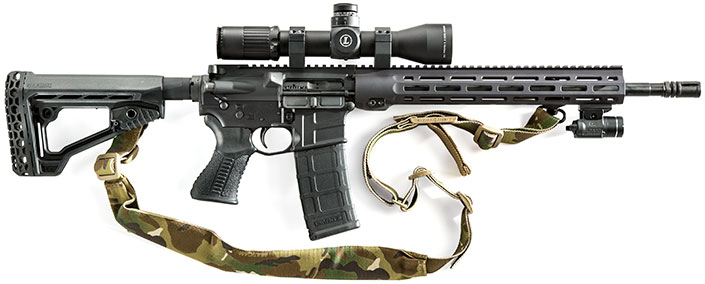
The Bottom Line
Whatever your budget, mission or time you can commit to training, put some thought into what exactly you expect your AR-15 to do. Using that information to inform your purchasing decisions will save your financial resources while also ensuring you have the best tool for the job. If you are ever forced to utilize it for the defense of yourself, your family or your community, you will be glad you made wise decisions in your selection of equipment. High-quality, well-selected equipment may hurt when you buy it, but it will pay for itself in spades over time. It also allows you to dedicate the maximum amount of resources possible to your training and practice, which, in the final analysis, is what carries the field in most defensive encounters.
About the Author
John Chapman (Chappy) is a police officer with more than 25 years of full-time and reserve service in patrol, training and SWAT positions. He is currently a SWAT team leader, and has completed thousands of hours of firearms and CQB training with some of the world’s best instructors. Chappy has taught in the private sector since 1999, serving armed citizens, police officers and military units, most recently as an instructor for EAG Tactical. Chappy, along with John Spears, recently founded Forge Tactical, an advanced-tactics-focused training firm, to carry on the legacy of EAG.














